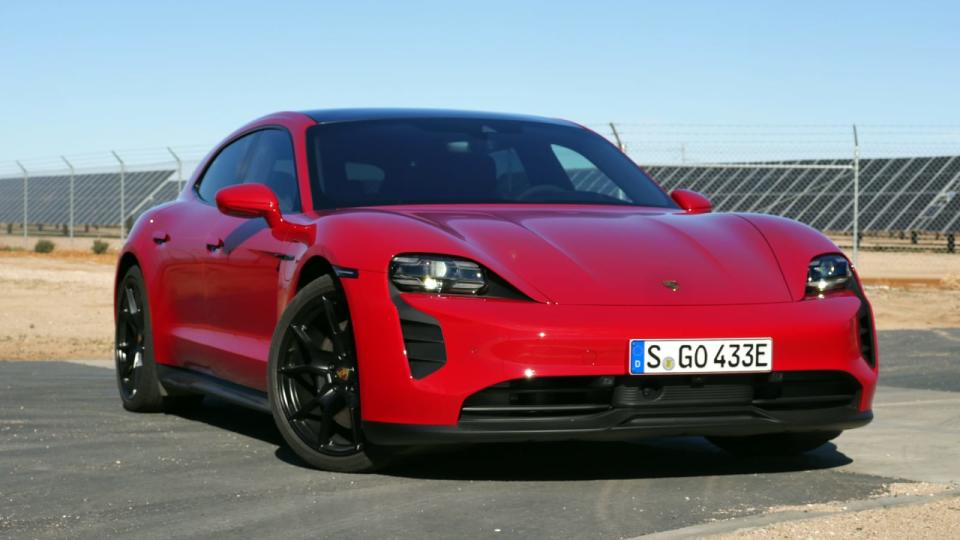2025 Porsche Taycan First Drive Review: How does 938 hp sound?

SEVILLE, Spain – When the Porsche Taycan debuted in 2020, it was a revelation. At the time, its closest all-electric rival was the Tesla Model S – the Taycan was also ridiculously quick, but represented a more complete package with sharp handling, trustworthy brakes and more repeatable performance. In the time since, the related Audi E-Tron GT and more luxurious alternatives such as the Mercedes EQS, EQE, and Lucid Air have mounted challenges, but none have touched the Taycan in terms of holistic performance. Doing so would likely mean adding an extra digit to the price tag by opting for niche EVs from Rimac or Pininfarina.
That certainly doesn't mean Porsche could rest on its laurels though, and for 2025, the Taycan gets a significant refresh, and we're not talking about just a minor styling update. No, the new Taycans are more powerful, have greater range, and are quicker both in a straight line and when recharging, ensuring that its current and future rivals will struggle to keep up.
From the outside, the 2025 Porsche Taycan retains its sleek and curvaceous body. The changes are subtle, with the most noticeable difference being the revised air inlets in the front fascia for most models. The new scoops are more conventional instead of the previous vertical slash that ran from the edge of the headlights down. Turbo models continue with the vertical inlet, though with a new angular inset panel that sharpens the face. This alteration, along with many more unseen ones, aren't just for aesthetics. They offer minor aerodynamic improvements that contribute to a larger increase in efficiency and range.


Original front-end design on a GTS and the revised design for 2025
As before, the rear-drive Taycan and all-wheel-drive Taycan 4S are available with two battery options, both of which are upgraded for 2025. The standard Performance goes up to 89 kilowatt-hours (previously 70), while the optional Performance Plus now crosses the triple-digit threshold at 105 kWh (previously 93). Range estimates were not available for the standard battery, but Porsche claims the rear-drive/Performance Plus combo now travels 35% further for a total of 421 miles when using the optimistic European WLTP testing standard. Eventual EPA estimates should be much lower, but still north of 300 miles. Having more battery cells is certainly a big contributor, but there were many other tweaks, as well.
Improved thermal management, more efficient motors, improved wheel aerodynamics, and lower rolling resistance tires also come together to add precious range. High-speed brake regeneration has also increased by as much as 30%, according to Porsche. Altogether, that means you'll have a good bit less range anxiety.
When you do need to replenish the battery, you'll be spending less time at a DC fast-charger since the rate has increased from 270 kilowatts to 320 kW. In practical terms, you can get from 10% capacity to 80% in only 18 minutes under ideal conditions, as opposed to the 5-80% in 23 minutes its predecessor required. The Taycan accomplishes this with its ability to maintain its peak charge rate longer and in a wider band of operating temperatures, despite having a larger capacity than before. Of course, that assumes you can find an operational and unoccupied charger capable of such loads, but hey, progress is progress, right?
All of these improvements help with practicality, but Porsche drivers are all about performance. And they’ll definitely get it for 2025. Every Taycan powertrain/battery combo is improved, but there are a lot of combos, plus the “Overboost Power with Launch Control” function needed for max acceleration – it can get confusing. To keep things as simple as possible, we’re just going with the Launch Control numbers. With the Performance Battery, the base, rear-drive Taycan increases to a 402-horsepower maximum from 321 horsepower. The Performance Battery Plus ups that to 429 hp from 375 hp. The all-wheel-drive 4S now produces 536 hp/590 hp (Performance/Performance Plus), versus 429 hp/482 hp.
Then there are the Turbo models, which all get the bigger battery. The Taycan Turbo now produces 871 hp with Launch Control, up from 616. That’s far more than the old Turbo S, which now finds itself with 938 hp versus 750. Woof. Porsche says the Turbo S now hits 62 mph in 2.4 seconds, an improvement of 0.4 second.

I managed to snag a Turbo sedan for the drive between Seville and the Circuito Monteblanco racetrack on a challenging scenic route and can unequivocally state that I was not wanting for more power. Launch control still manages to trigger a guttural giggle as your organs slosh around in your ribcage, providing the kind of confidence when passing slower traffic on narrow roads that few other cars can offer. With the artificial “Electric Sport Sounds” on, you get better feedback of how hard you're driving, and there's even a subtle indication of the rear motor's two-speed transmission shifting.
The brake-by-wire system gets the 5,000-plus-pound sedan slowed in a hurry, and it's also easy to modulate when you feel like trailing the pads all the way down to an apex. There's no appreciable transition between brake regeneration and when the physical binders take hold, but the pedal itself feels slightly spongy for a performance car. Tapping the new push-to-pass button on the steering wheel gives you a bit more oomph for a moment, but if you're expecting a "go-baby-go" nitrous button, this isn't it.

 Yahoo Autos
Yahoo Autos 
